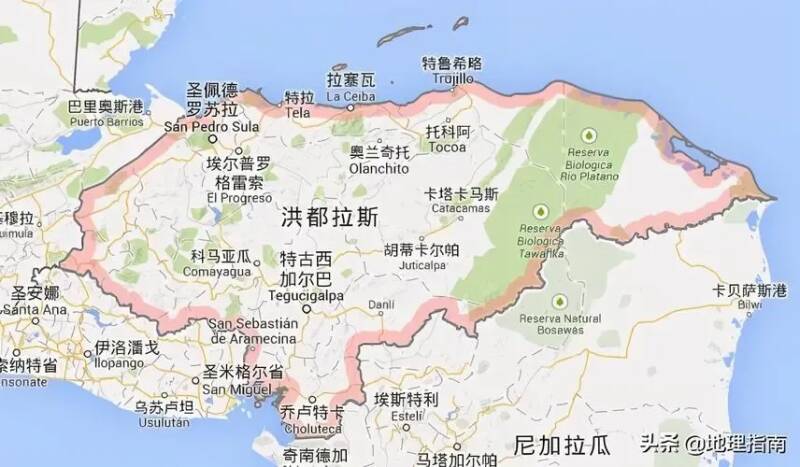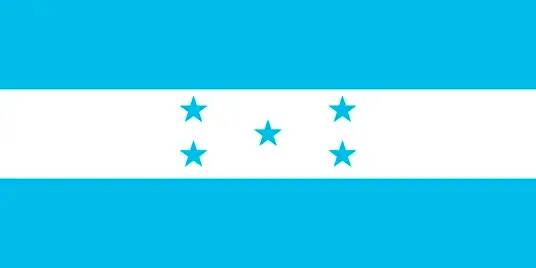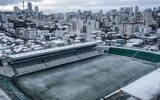Honduras| Introduction to coffee growing areas and varieties
Honduras Honduras
Honduras, whose full name is the Republic of Honduras (Rephost blica de Honduras), is located in the north of Central America, with the Caribbean Sea to the north, the Gulf of Fonseca in the Pacific Ocean to the south, and Nicaragua, El Salvador and Guatemala to the south. It covers an area of 112500 square kilometers and is divided into 18 provinces.

The flag of Honduras consists of three parallel rectangles, blue, white and blue, from top to bottom, while there are five blue pentagram in the middle of the white rectangle. The color of the national flag comes from the color of the former Central American Federation, the upper and lower blue stripes symbolize the Pacific Ocean and the Caribbean respectively, and the middle white symbolizes the pursuit of peace. The five five-pointed stars were added in 1866 to express the vision that the five countries that make up the Central American Federation can once again unite.

More than 3/4 of the country in Honduras are mountains and plateaus, with mountains extending from west to east, inland lava plateaus, intermountain valleys, and coastal areas as plains, with forests accounting for about half of the country's area. Honduras has a tropical climate, the coastal plains have a tropical rain forest climate, with an average annual temperature of 23 ℃ and abundant rainfall, with annual rainfall of up to 3000 mm in the northern coastal and mountainous areas, but between May and July each year, tornadoes form parts of the sea, sweeping fish into the sky and then throwing them into parts of the country, creating the spectacle of fish rain.
Honduras is one of the least developed countries in Latin America. Agriculture is the leading industry of the national economy, and its industrial base is relatively weak. Agriculture is dominated by coffee, with 280000 hectares of coffee gardens in the territory, dominated by small coffee merchants, with soybeans less than 3.5 hectares. These coffee traders account for 60% of the country's production and have become the second largest coffee exporter in Central America and the tenth largest coffee exporter in the world.
Coffee producing area
In 1970, the Honduran Coffee Institute (IHCAFE) was established by the Honduran government to help local coffee farmers improve their planting techniques and improve the quality of coffee, and six producing areas are divided into Copan, Opalaca, Montecilos, Conayagua, Agalta Tropical and El paraiso, with an average elevation of more than 1100 meters. November to March is the picking season every year.
Copan District (Copan): located between the provinces of Copan, Ocotepeque and Lempira in the western part of the country, showing a strong chocolate flavor, combining the sweetness of honey and caramel as its characteristics, the fruit flavor is relatively light, planting elevation of 1000-1500 meters, annual precipitation of 1300-2300 mm, mainly growing bourbon Bourbon, Kaduai Catuai, Pacas Pacas, Lompilla Lempira, IHCAFE-90.
Opalaca: located between Santa B á rbara in Santa Barbara, Intibuc á in Intibuka and Lempira in Lompira, it has very delicate acidity, overall balance, taste of tropical fruits such as grapes, mulberries, etc., with a strong lemon flavor, neutralized with honey and caramel sweetness, with obvious fruit flavor, 1100-1700 meters above sea level, and annual precipitation production of 1350-1900 mm. Mainly grow bourbon Bourbon, Kaduai Catuai, Lompilla Lempira, iron pickup Typica.
Montesius (Montecilos): located between La Paz, Comayagua in La Paz, Santa B á rbara and Intibuca in Santa Barbara, it is full of fruity and sweet aromas with lemon and floral flavours. Lemon and fruit aromas are important features, especially peaches and oranges, with lively and bright acidity, velvety texture and a lingering finish. 1200-1700 meters above sea level, with an annual precipitation of 1300-2300 mm; from December to April of the following year, the main plants are bourbon Bourbon, Kaduai Catuai, Lompilla Lempira and Pacas Pacas
Gongma Agua (Conayagua): located between Comayagua, Comayagua and Francisco Moraz á n, Francisco-Morasan, mainly with lemon flavor, obviously sweet fruit aroma, taste more like cream mellow, but also with citrus sweetness, and exudes sweetness and chocolate flavor, elevation 1100-1700 meters, annual precipitation production of 1350-1700 mm, mainly growing bourbon Bourbon, iron pickup Typic, Kaddura Caturra, Lompilla Lempira.
Akata (Agalta Tropical): this region, which spans parts of Olancho in Orlanjo, El Paraiso in Parasso and Francisco Moraz á n in Francisco-Morasan, is mainly the eastern province and is the most scattered area. It consists of 14 protected areas to increase their plant diversity to balance the ecosystem and is of high ecotourism value. The aroma and aroma of honey, it has a strong citrus flavor and subtle and obvious acidity, and a pleasant finish. 1100-1700 meters above sea level, with an annual precipitation of 1350-1950 mm. Mainly planted bourbon Bourbon, iron pickup Typic, Kaddura Caturra, Lompilla Lempira.
El paraiso: located in southern Honduras, between the provinces of El Para í so in Palaso, Choluteca in Cholutka and Olancho in Orlanjo. Coffee is mainly with gentle acidity, caramel flavor and well-balanced taste. 1100-1700 meters above sea level, with annual precipitation of 950-1950 mm, mainly growing Kaduai Catuai, Kaddura Caturra, Pacas Pacas, Lompilla Lempira.
Important Notice :
前街咖啡 FrontStreet Coffee has moved to new addredd:
FrontStreet Coffee Address: 315,Donghua East Road,GuangZhou
Tel:020 38364473
- Prev

How to use the V30 hand-brewed coffee filter cup? How many coffee beans should I use for one serving of coffee?
As we all know, the Hario V60 we are familiar with has two models, Model 01 and Model 02. Compared with the two, the V60 No. 02 is larger and can hold more coffee powder. It is not a problem to brew for 4 to 5 people at a time. Like the No. 01 filter cup commonly used in Qianjie, the amount of brewing powder is recommended to control
- Next

Cold current is coming!? Brazil is about to be hit by frost, coffee and other agricultural departments are worried about affecting future production
It is understood that although Brazil is located in the southern hemisphere and in the tropics, under normal circumstances, Brazil has four seasons a year, and winter will be ushered in from June to September every year. However, this year due to the impact of the El Niño phenomenon, winter shows signs of coming early. Therefore, on April 18, the Brazilian National Meteorological Institute released
Related
- Being chased out of the rain in front of Starbucks?! Store: Sheltering from rain under umbrellas poses a safety hazard
- The white moonlight has changed?! Lucky launches "Big Winter Pear American"
- Hand-brewed coffee three-stage method, high-sweet and universal brewing method to share! What does the high sweet water level of hand-brewed coffee mean?
- What is the difference between raw, refined and full espresso coffee? How to extract espresso and taste good?
- A complete list of coffee bean names and their meanings! What is Yejia Shefi coffee? Where is Mantelin coffee?
- What grade does Arida Manor Kaduai coffee beans belong to? What treatment is Arida ASD slow anaerobic sun exposure?
- The milk tea cup becomes smaller?! Overlord Tea Girl launches a new "Return to Yunnan" series
- Accused of selling counterfeit and high-priced coffee beans! Well-known boutique coffee brand "Oukelao" bowed and apologized!
- How to make espresso dumplings? Can I eat coffee and glutinous rice balls together?
- Save the unformed and stagnant powder cakes in one second! What is the problem with stagnant water in the powder bowl of the espresso machine?

